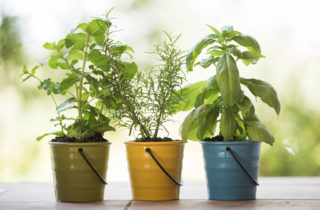Growing kitchen herbs is a win-win. You get to fill your yard or windowsill with…
You might’ve heard of propagation before, but do you know what it is exactly? It’s simple: propagating means taking cuttings, such as stems, roots, leaves, or seeds and growing new plants from them. This method is excellent if you’re on a budget or want to extend your passion for recycling to the garden.
Stems
All you need to get started with stem propagation is some pruning shears, containers to grow all the cuttings, potting mix, and a rooting hormone (ask for some at your local nursery). With the shears, cut a section of the stem that’s three to six inches long. Remove the lower leaves and dip the stem into the rooting hormone. Immediately put your stem into the moist potting mix in one of your containers and voila—you’ve just created a new plant. If you keep the container out of direct sunlight and the soil moist, your stems should have no problem propagating.
Leaves
It’s a bit trickier, but some plants can propagate from just a leaf cutting. If you have just the leaf itself, cut it up and plant it vertically into the soil. If you also have the petiole—the stalk that holds the leaf to the plant—then insert one and a half inches of the stalk into the soil.
Roots
Your best luck in propagating from a root is to cut during the dormant season. Aim to cut a two- to six-inch section that’s as thick as a thick wire and plant in your container. Just like with the stem cuttings, you need to keep these as moist as possible.
Seeds
Of course, you can always grow plants from seeds you buy at the store, but to be truly economical, you can use the seeds from the plants you’re already growing. There are two types of seeds: fleshy and dry. Fleshy seeds are found in fruits and require that the fleshy part is removed before planting. When choosing dry seeds, look for ones that are brown and withered. Bury the seed about three to four inches deep in your soil and feel free to plant more than one in each container to increase the chances of a successful propagation.
Just as growing new plants through propagation is a way to increase your plant supply, SAWS uses innovative techniques to increase the city’s water supply. With eight different sources, 16 pioneering water projects, and strategic conservation techniques, San Antonio is in great shape to have enough high-quality water for years to come.


